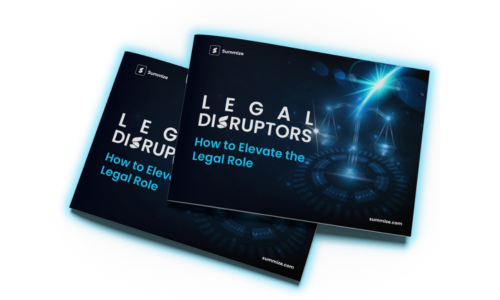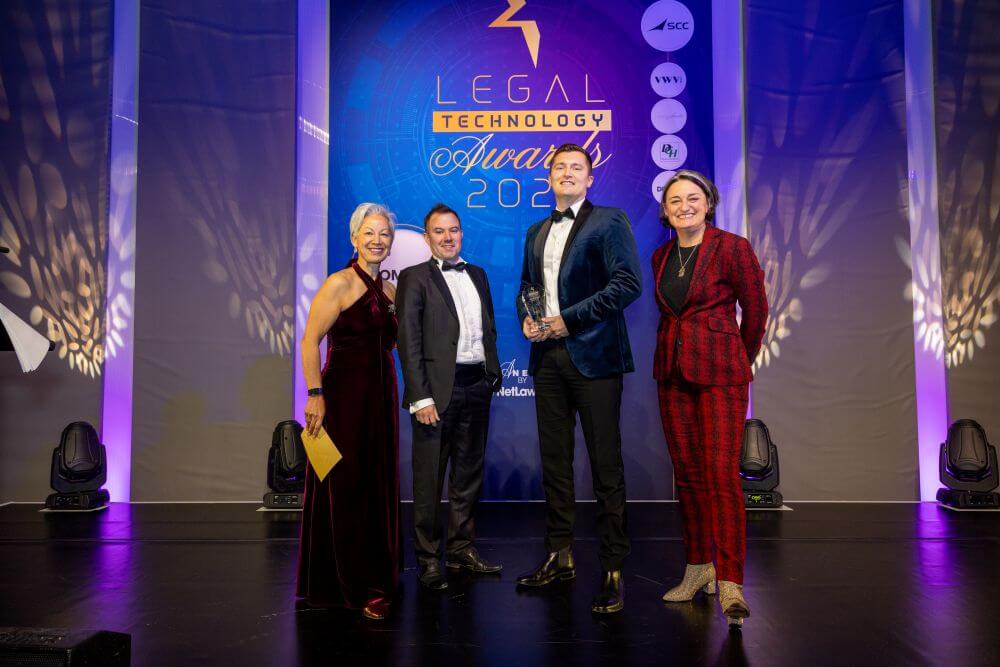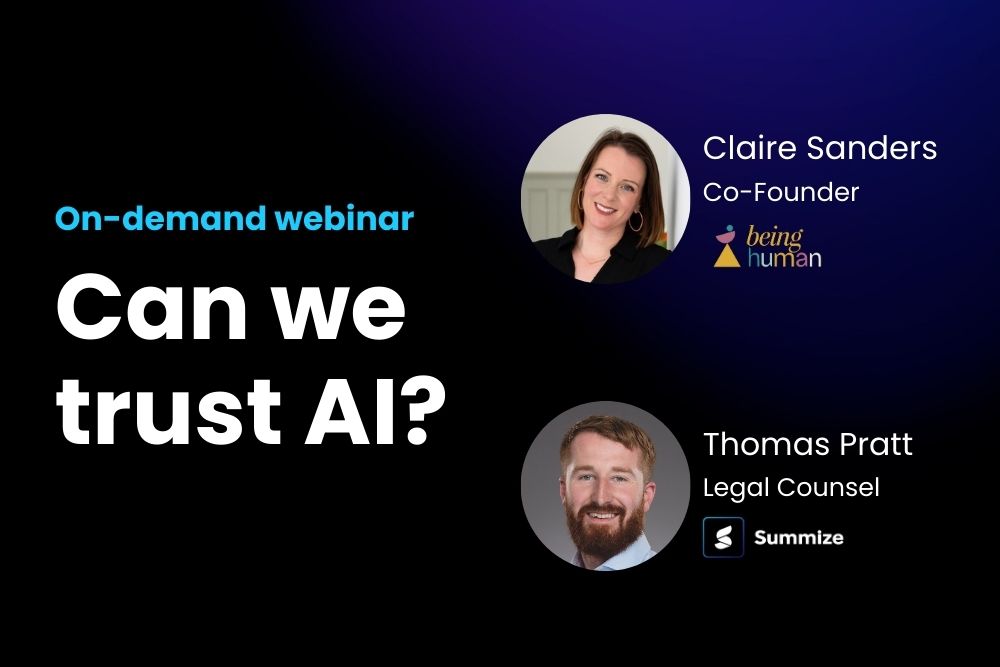Understanding decentralized contract management
Explore the future of CLM and how Summize transforms contract management with a decentralized approach, prioritising end-user experience and ecosystem.
March 5, 2024
November 25, 2025
With multiple teams and stakeholders, the contract lifecycle management process can be challenging. In fact, research from Artificial Lawyer found that 77% of inhouse counsels experienced failed technology implementation. Why?
Implementing the right CLM solution can significantly impact your legal team and wider business. So, to ensure that your chosen solution can deliver a meaningful ROI as well as address your contractual challenges, it is key to research the market and vendors beforehand.
However, it’s easy to think that a solution is right for your business based on its appearance in a demo. But you also need to identify the key stakeholders in the process and their project requirements. The first rule of legal tech is it’s not just for legal!
By 2025, Gartner predicts that corporate legal teams will only capture 30% of the benefits from their CLM investments due to pursuing roadmaps that lack sufficient regard for business requirements and end-user needs.
Evolution of the virtual office
Before considering investment in a CLM, you must first consider the software approach and ethos of the wider business to ensure it will complement the current and future ways of working.
Workplace technology has become a cornerstone of modern business operations. Originally a catalyst of the pandemic, a profound shift is underway, with organizations transitioning from traditional on-premise infrastructure to cloud-based solutions.
With companies adopting a hybrid or remote working model, flexible and deskless work requires companies to invest in a robust ecosystem of tech to ensure they are maximizing collaboration.
At the forefront of this transformation is the mass adoption of cloud operating systems, where industry giants like Office 365, Google Suite, and more recently, Slack, are fighting for supremacy in this market. But this transition signifies more than just a change in technology; it marks the entry point to the workforce of the future.
While the adoption of cloud-based platforms has accelerated the pace of innovation, it has also introduced a new challenge: the fragmentation of workflows across a multitude of applications.
In response, companies turned to middleware solutions like Zapier, aiming to bridge the gap between disparate systems and streamlined operations. Yet, these integrations, while valuable, often represent a superficial connection and are not conductive to the seamless benefits of real-time collaboration.
We believe SaaS solutions must evolve beyond mere plug-in integrations and embrace native and embedded integrations into the fabric of the cloud system. Native integrations eliminate the need for middleware software, providing a seamless and embedded user experience where workflows flow effortlessly between applications, enabling businesses to unlock a new level of efficiency and productivity.
Once you can align with your organization’s vision for the future of work, you can assess and select a CLM technology accordingly.
The evolution of CLM and its future
Traditionally, contracts would have been stored in a filing cabinet. But today, SharePoint is the most common. You would create a basic folder structure for contracts and they’ll start storing them. Of which, most won’t be seen again until something goes wrong. Now you have contracts in SharePoint, but you’ll also have contracts on someone’s computer, the people management system and maybe even a filing cabinet; then those who are following the business process, will have contracts in your ERP or CLM as well.
And if you try to join the dots up across each department to see how much time they spend, you’ll struggle to get an accurate report!
To solve these challenges, the next step forward for legal tech was the evolution of the full end-to-end Contract Lifecycle Management solution.
Platform-based CLM vs Decentralized CLM
Platform-based CLM solutions have one common problem. It can be a complicated tool that not everybody knows how to effectively use, especially outside of legal. Not everyone has access to it. Plus, it sits outside of the business's existing ecosystem. What quickly happens is that different individuals and different groups within the business come up with their own ways of managing their contracts.
The key to success with CLM is to focus on the business-wide adoption of the solution, which requires a new way of thinking and a different approach to the CLM architecture.
The context of the wider business and the approach to technology cannot be overlooked. Even in the face of budget cuts and rising overheads, ecosystems and tech stacks are still vast! Research by Zylo in 2023 found that on average small businesses with less than 500 employees have 127 apps. Medium-size companies between 501 and 2,500 employees have 255 apps. And for enterprise businesses, they have twice as many apps, averaging 664.
However, the trend to add more applications to the business to solve disparate issues is changing. 2023 saw an 11% decrease in the number of applications being managed, as organizations focused on identifying and merging duplicate applications to become more streamlined.
In the face of dwindling budgets and pressure to do more with less, organizations are moving away from point-and-click software that fails to deliver the anticipated benefits due to low user adoption and engagement.
With this in mind, the key to the successful adoption of any technology is to find a way for it to work within the common software platforms that are already used every day by the majority of the business.
We call this the Decentralized CLM.
The Summize approach
Summize has taken a different approach to CLM architecture. The decentralized approach is to create a digital thread that spans every contract interaction and links them all together across your suite of business applications. With this approach, the user experience (rather than the platform experience) is paramount. Regardless of where the journey starts, your contract processes are embedded into existing ways of working.
In this context, think of it as a digital thread that follows the contract process from start to finish, regardless of where the journey starts. It’s about keeping all the digital information connected and flowing smoothly during its entire lifecycle.
Everyone involved with contracts can easily find and understand the information at each stage, with minimal training, distraction or loss of productivity.
Taking this approach, there’s less change management, less friction and ultimately, wider adoption of the contract processes consistently across departments.
The focus is on enabling the business to self-service, removing the bottle necks from the legal team. Whether the user originates a request out of Salesforce or Slack, it enables users to create, review, collaborate and ask questions of their contracts, all within their familiar applications – with the digital data tracked right through to the final version of the signed contract and beyond.
While the CLM core platform still provides all of the essential legal functionality for power users, the rest of the business can surface contract information and interact with contract processes from within existing tools, without navigating to and interacting with the CLM in the back end.
Summize is underpinned by AI but with human-centric design at the core – bringing speed, automation and intelligence to the way your legal and commercial teams create, negotiate and manage contracts across the entire business.
This decentralized approach makes contract negotiation faster and smarter, reducing legal risk and enabling huge time-saving efficiencies across the business. We believe the future of legal technology is to create an ecosystem that works for everyone, not just for legal.
Discover even more!
Explore more about contracting and CLM in our ultimate contract guides








